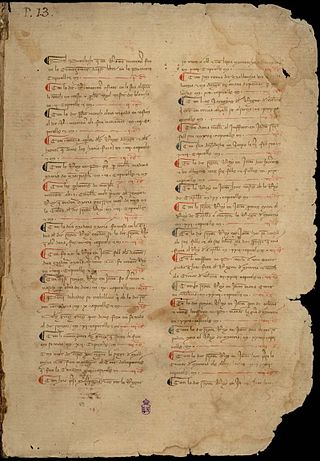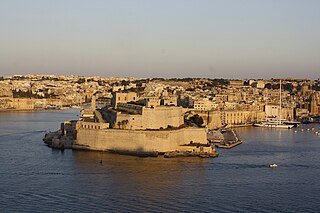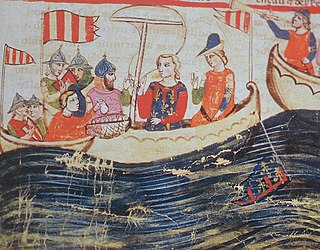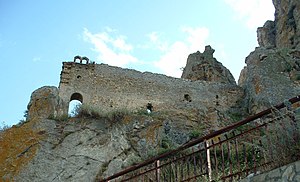
Peter III of Aragon was King of Aragon, King of Valencia, and Count of Barcelona from 1276 to his death. At the invitation of some rebels, he conquered the Kingdom of Sicily and became King of Sicily in 1282, pressing the claim of his wife, Constance II of Sicily, uniting the kingdom to the crown.

Frederick II ; 13 December 1272 – 25 June 1337) was the regent of the Kingdom of Sicily from 1291 until 1295 and subsequently King of Sicily from 1295 until his death. He was the third son of Peter III of Aragon and served in the War of the Sicilian Vespers on behalf of his father and brothers, Alfonso ΙΙΙ and James ΙΙ. He was confirmed as king by the Peace of Caltabellotta in 1302. His reign saw important constitutional reforms: the Constitutiones regales, Capitula alia, and Ordinationes generales.

The Catalan Company or the Great Catalan Company was a company of mercenaries led by Roger de Flor in the early 14th century and hired by the Byzantine Emperor Andronikos II Palaiologos to combat the increasing power of the Anatolian beyliks. It was formed by almogavar veterans of the War of the Sicilian Vespers, who had remained unemployed after the signing in 1302 of the Peace of Caltabellotta between the Crown of Aragon and the French dynasty of the Angevins.

Walter V of Brienne was Duke of Athens from 1308 until his death. Being the only son of Hugh of Brienne and Isabella de la Roche, Walter was the heir to large estates in France, the Kingdom of Naples, and the Peloponnese. He was held in custody in the Sicilian castle of Augusta between 1287 and 1296 or 1297 to secure the payment of his father's ransom to the Aragonese admiral Roger of Lauria. When his father died fighting against Lauria in 1296, Walter inherited the County of Brienne in France, and the counties of Lecce and Conversano in southern Italy. He was released, but he was captured during a Neapolitan invasion of Sicily in 1299. His second captivity lasted until the Treaty of Caltabellotta in 1302.

The Battle of Malta took place on 8 July 1283 in the entrance to the Grand Harbour, the principal harbour of Malta, as part of the War of the Sicilian Vespers. An Aragonese fleet of galleys, commanded by Roger of Lauria, attacked and defeated a fleet of Angevin galleys commanded by Guillaume Cornut and Bartholomé Bonvin.

Roger of Lauria (c. 1245 – 17 January 1305), was a Calabrian admiral in Aragonese service, who was the commander of the fleet of the Crown of Aragon during the War of the Sicilian Vespers. He was probably the most successful and talented naval tactician of the Middle Ages. He is known as Ruggero or Ruggiero di Lauria in Italian and Roger de Llúria in Catalan.

The Battle of the Gulf of Naples was a naval engagement during the War of the Sicilian Vespers. Fought on 5 June 1284 in the south of the Gulf of Naples, the battle saw a Aragonese–Sicilian fleet commanded by Roger of Lauria defeat a Angevin fleet commanded by Prince Charles of Salerno. Charles was captured during the battle, and the Aragonese victory helped secure Aragonese control of the sea around Sicily.

The Battle of the Counts was a naval engagement during the War of the Sicilian Vespers. Fought on 23 June 1287 between the fleets of Aragon-Sicily and Angevin Naples, the battle was a major victory for the Aragonese fleet and its commander, Roger of Lauria.
The naval Battle of Cape Orlando took place on 4 July 1299 at St Marco di Val Demone, north-western Sicily, when an Aragonese and Angevin galley fleet commanded by Roger of Lauria defeated a Sicilian galley fleet commanded by Conrad d'Oria. King James II of Aragon and Frederick III of Sicily were present with their fleets at the battle. The larger Aragonese–Angevin fleet was trapped on a lee shore but was able to win the battle with the intervention of its six-galley reserve that attacked the rear of the Sicilian fleet. The Sicilians fled when the flagship, with Frederick aboard, pulled back after the king collapsed from heat and exhaustion. Eighteen Sicilian vessels were captured and their crews massacred. The battle allowed for the invasion of Sicily but James, breaking with his Angevin allies, withdrew his force to Aragon and Frederick was able to defeat the Angevin army on land and secure the independence of Sicily in the Peace of Caltabellotta.

Aci Castello is a comune in the Metropolitan City of Catania in Sicily, Italy. The city is located 9 kilometres (6 mi) north of Catania on the Mediterranean coast. The primary economic sectors are agriculture and industry. The city is neighbored by Aci Catena, Acireale, Catania, San Gregorio di Catania and Valverde.

The Castello Maniace is a citadel and castle in Syracuse, Sicily, southern Italy. It is situated at the far point of the Ortygia island promontory, where it was constructed between 1232 and 1240 by the Emperor Frederick II. It bears the name of George Maniakes, the Byzantine general who besieged and took the city in 1038. Originally, one could only enter the castle over a bridge spanning a moat. A feature of the castle is the decorated portal. Today the castle is open to the public and is a local tourist attraction in Syracuse.

The War of the Sicilian Vespers, also shortened to the War of the Vespers, was a conflict waged by several medieval European kingdoms over control of Sicily from 1282 to 1302. The war, which started with the revolt of the Sicilian Vespers, was fought over competing dynastic claims to the throne of Sicily and grew to involve the Crown of Aragon, Angevin Kingdom of Naples, Kingdom of France, and the papacy.

The Battle of the Col de Panissars was fought on 30 September and 1 October 1285 between the forces of Philip III of France and Peter III of Aragon. It was a severe defeat for the French, who were already retiring over the Pyrenees when the Aragonese fell on them.
The Battle of Falconaria was fought in the latter days of the War of the Sicilian Vespers. Fought on 1 December 1299 between the forces of Frederick II of Sicily and Philip I of Taranto of the Kingdom of Naples, it was a momentous victory for Frederick and a disaster for Philip, who was captured.

Gagliano Castelferrato is a comune in Sicily, Italy in the Province of Enna. The town was the site of the Battle of Gagliano in 1300 during the War of the Sicilian Vespers.
The County of Malta was a feudal lordship of the Kingdom of Sicily, relating to the islands of Malta and Gozo. Malta was essentially a fief within the kingdom, with the title given by Tancred of Sicily the Norman king of Sicily to Margaritus of Brindisi in 1192 who earned acclaim as the Grand Admiral of Sicily. Afterwards the fiefdom was passed from nobleman to nobleman remaining as a family possession in a few instances. It was used mainly as a bargaining tool in Sicilian politics leading to a rather turbulent history. The fiefdom was elevated to a Marquisate in 1392 and either title was no longer used after 1429.
An incomplete list of events in 1299 in Italy:

The Castello Normanno, or alternatively the Castello di Aci, is a castle in Aci Castello in the Metropolitan City of Catania in Sicily, southern Italy. The castle is situated on a rocky outcrop jutting out into the sea. Its precise date of construction is uncertain, but it was important to the development of its region during the Middle Ages. During the War of the Sicilian Vespers, it was subject to Roger of Lauria. It was besieged more than once, and was briefly controlled by the Spanish. It is currently a museum.
Blasco I Alagona or d'Alagona, called the Elder, was an Aragonese nobleman and soldier in the service of the Kingdom of Sicily after 1285. His family was originally from Alagón. As a military commander, he was noted for his adept use of mobile infantry against heavy cavalry.

The Angevin invasion of Sicily (1298–1302) was a military campaign launched against the Kingdom of Sicily by an alliance of the Angevin Kingdom of Naples, the Crown of Aragon, and the papacy during the War of the Sicilian Vespers. Fought in the final years of the 20-year long war, the campaign saw the alliance make some territorial gains on the island before ultimately withdrawing in the face of Sicilian resistance.















